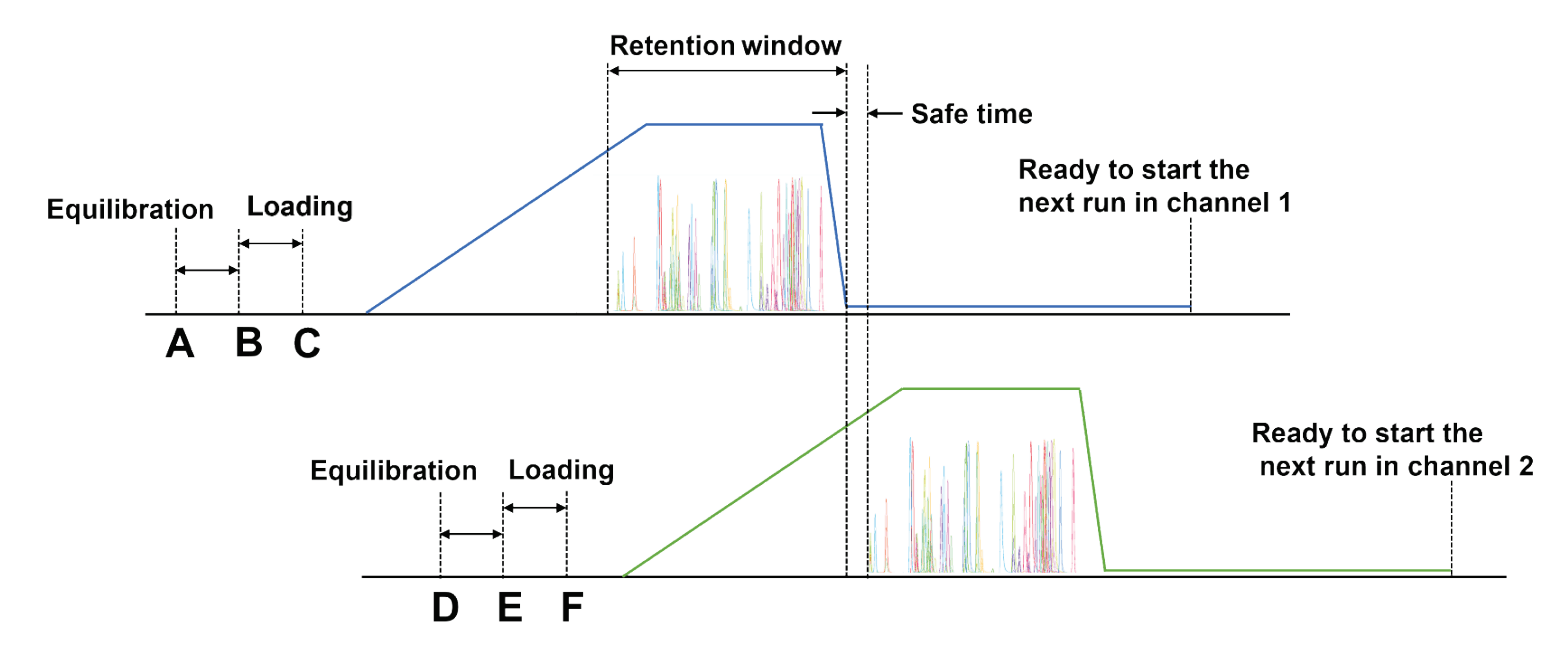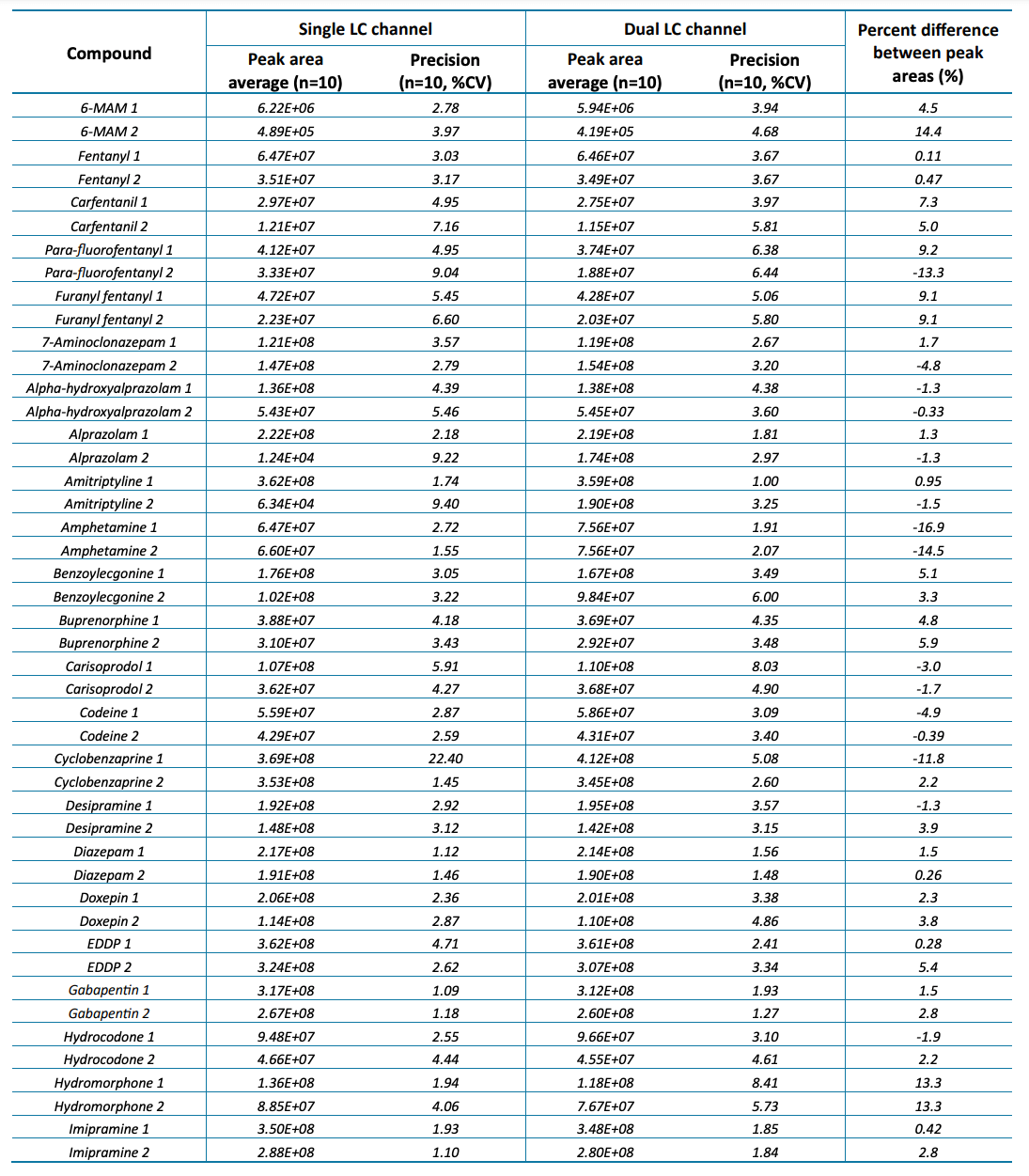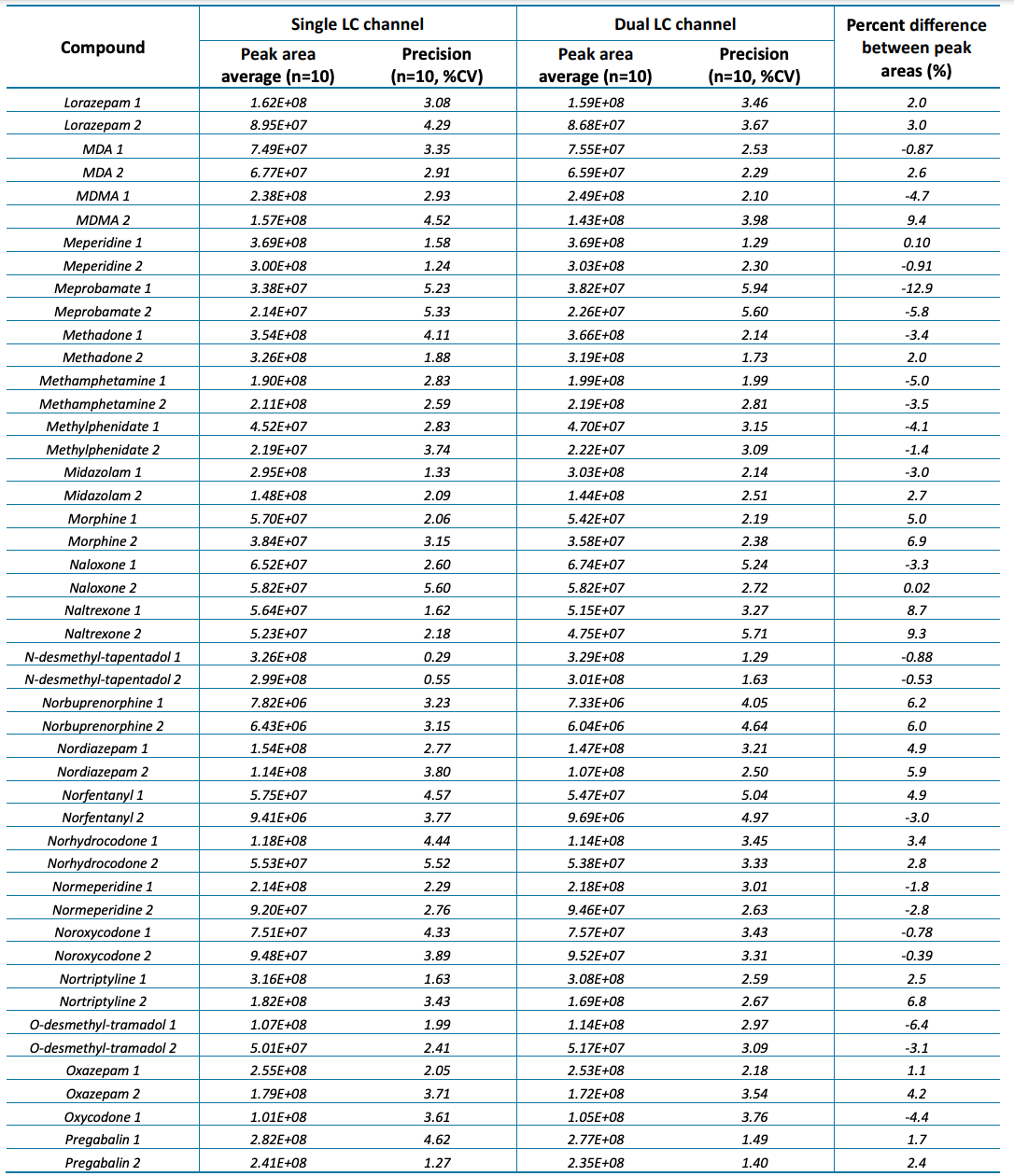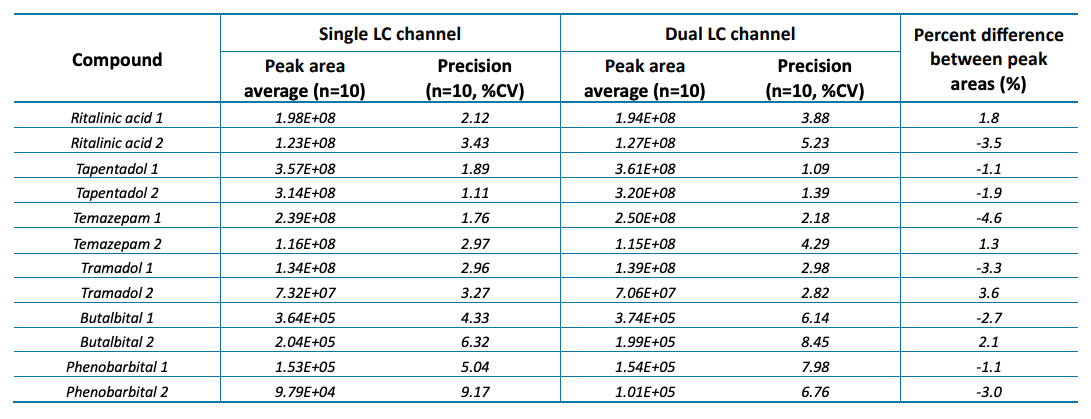Improving laboratory throughput using LC multiplexing
Casey Burrows and Pierre Negri
SCIEX, USA
Published date: March 17, 2024
Abstract
This technical note demonstrates a comprehensive LC multiplexing solution to improve laboratory efficiency and productivity. Sample throughput was increased by as much as 2- fold by coupling the SCIEX 7500 system with 2 independent flow channels on the Transcend VLX-2 UHPLC system. Using both the traditional single LC channel and multiplexed dual LC channels (n=10 each), the analysis of 55 drugs of abuse showed comparable analyte peak areas with percent difference generally within 10%. Further, the precision for both methods was <10%, demonstrating good analytical performance for applicability to routine testing laboratories.
Introduction
Improving laboratory efficiency and productivity is critical to provide faster turnaround times and eliminate backlog. One strategy commonly used to improve sample throughput in LC-MS/MS-based workflows is LC multiplexing, a methodology in which 2 LC streams are run simultaneously before being introduced to the mass spectrometer (Figure 1). This technique provides routine testing laboratories a way to achieve time savings by improving sample throughput, while enabling multi-assay sample analysis on the same LC-MS/MS system.
Key benefits of coupling SCIEX mass spectrometers with the Transcend VLX-2 UHPLC system for highthroughput workflows
- Enhanced sample throughput: Minimized MS/MS redundancy time during LC column equilibration, loading and dead volume can improve throughput by as much as 2-fold
- Multi-assay capability: The ability to run 2 independent flow channels in parallel increases sample throughput while enabling multi-assay sample analysis on a single LC-MS/MS system
- Chromatography and data quality: Multiplexing of 2 LC streams into a single mass spectrometer maintains chromatographic performance and data integrity
- Software usability: Seamless integration between SCIEX OS software and Thermo Scientific Aria LC control software
Figure 1. Schematic showing the benefits of LC multiplexing. LC multiplexing allows staggering of sequential sample injections into 2 LC channels in parallel. This configuration minimizes MS/MS redundancy time during LC column equilibration, loading and dead volume, which significantly improves sample throughput.
Methods
Targeted analytes: A drugs of abuse panel consisting of 55 analytes was selected for this study.
Sample preparation: A 10 ng/mL standard mixture containing the 55 drugs of abuse was prepared in water. This standard mixture was used to compare runtimes and the throughput capabilities of the multiplexing solution.
Liquid chromatography: Chromatographic separation was performed on a Thermo Scientific Transcend VLX-2 UHPLC system using a Phenomenex Kinetex™ Phenyl-Hexyl column (50 × 2.1 mm, 2.6 µm, P/N: 00B-4495-E0) in each of the 2 LC channels. Mobile phases were identical for both LC streams and consisted of 10mM ammonium formate in water (mobile phase A) and 0.05% formic acid in methanol (mobile phase B). The injection volume was 5 µL and the LC runtime was 7 min. Two identical sample batches were created that consisted of 1 blank injection followed by 10 standard mixture injections (10 ng/mL). The first batch was run on a single LC channel and the second was run on a dual LC channel to compare the time savings. All switching valves and the synchronization between the LC components and mass spectrometers were controlled by Thermo Scientific Aria LC control software.
Mass spectrometry: A SCIEX 7500 system equipped with an OptiFlow Pro ion source with an electrospray ionization (ESI) analytical probe and E Lens probe was used. An acquisition method consisting of 106 MRM transitions (2 for each analyte) and a 250 ms cycle time was created using the scheduled MRM algorithm to ensure comprehensive coverage and the highest data quality in both positive and negative modes. Compound-dependent parameters were optimized for each of the 55 analytes by infusion. Source and gas parameters included: ISV = 3000 V, CAD = 9 psi, CUR = 40 psi, Gas 1 = 60 psi, Gas 2 = 60 psi, TEM = 600°C.
Data analysis: Data processing was performed in SCIEX OS software, version 3.1. Detection and integration of the peaks from the background were achieved within the viewing window using the AutoPeak algorithm.
Throughput improvements
The time savings resulting from the use of dual LC channels were investigated by running 2 identical sample batches consisting of 11 consecutive injections. When using the single LC channel, a new sample was injected once the previous experiment was completed. When using the dual LC channel batch, the second sample was injected in the second LC channel while the previous sample was being analyzed using the first LC channel. As a result, the use of dual LC channels improved sample throughput. Figure 1 illustrates the benefits to time savings achieved by LC multiplexing running dual LC channels.
Figure 2 shows the Queue panel in SCIEX OS software after the completion of a sample batch consisting of 11 consecutive injections (1 blank followed by 10 standard mixture injections) using either the single LC channel (Figure 2A) or the dual LC channels (Figure 2B). The use of the single LC channel resulted in an acquistition time of 7:07 min per sample, whereas the use of the dual LC channels achieved an acquisition time of 4:25 min per sample. As shown in Figure 2, running the batch of samples using the single LC channel resulted in a total runtime of 85 min, compared to 49 min with the dual LC channels. These results demonstrate that the use of dual LC channels resulted in a 1.7× improvement in sample throughput.
Figure 2. Comparison of Queue panels in SCIEX OS software that show the acquisition of 2 identical sample batches. Single LC channel (left) and dual LC channel (right) panels show the timestamps for 11 consecutive injections. The use of the dual LC channels resulted in a 1.7× improvement in sample throughput.
Analytical performance
The ability to deliver reproducible results for every injection of every batch is critical to implement LC multiplexing in routine testing laboratories. The robustness and reproducibility of the LC multiplexing system was investigated by comparing the measurement precision and the percent difference between the peak areas for the series of 10 standard mixture injections performed on the single LC channel to those performed on the dual LC channels. Detection of peaks from the background and peak integration were performed automatically within the viewing window using the AutoPeak algorithm in the Analytics module of the software to generate peak area values for the 2 MRM transitions used for each of the 55 drugs of abuse included in this method. Table 1 lists the precision values (n=10) calculated for each of the 55 drugs of abuse using the single LC channel (left) and the dual LC channels (right). The last column includes the percent difference between the peak areas for the injections performed on the single LC channel and those performed on the dual LC channels. The table shows comparable results between the injections performed with each of the 2 LC channel modes, with precision %CV values <10% for all the compounds targeted in the method, regardless of the LC channel mode used. This demonstrates that no difference in measurement precision was observed between the single and dual LC channel modes. Similarly, no significant difference in peak area was observed between the 2 modes, as evidenced by the low (between -16.9% and 14.4%) percent difference between the peak areas for the injections performed on the single LC channel and those performed on the dual LC channels. Overall, the results demonstrate the robustness of the LC multiplexing system and its ability to deliver precise and reproducible data while multiplexing injections.
Conclusion
The method demonstrated:
- A robust LC multiplexing solution enabled 2 LC channels while synchronizing to a single MS/MS system. Coupling the SCIEX 7500 system with 2 independent flow channels using the Transcend VLX-2 UHPLC system provided the level of throughput needed by modern laboratories to analyze increasing numbers of samples.
- The LC multiplexing system successfully ran 2 LC channels in parallel. Multiplexing led to a 1.7× improvement in time savings, enabling higher sample throughput for routine testing laboratories.
- This LC multiplexing system was highly reliable. Coupling the SCIEX 7500 system to the LC multiplexing platform provided reliable and reproducible data (%CV values <10%) while multiplexing injections.
- Overall, this LC multiplexing solution allowed for considerable time savings for analytical runs, which significantly improves overall laboratory throughput and efficiency without compromising chromatographic performance and data integrity
Table 1. Measurement precision (n=10) for the series of 10 ng/mL standard mixture injections performed on the single LC channel and on the dual LC channels. The precision values (%CV) were calculated for the 2 MRM transitions used for each of the 55 drugs of abuse. The precision values were <10% for all the injections, regardless of the channel mode used on the LC system.
Table 1. Measurement precision (n=10) for the series of 10 ng/mL standard mixture injections performed on the single LC channel and on the dual LC channels. Continued.
Table 1. Measurement precision (n=10) for the series of 10 ng/mL standard mixture injections performed on the single LC channel and on the dual LC channels. Continued.
 Click to enlarge
Click to enlarge Click to enlarge
Click to enlarge Click to enlarge
Click to enlarge Click to enlarge
Click to enlarge Click to enlarge
Click to enlarge